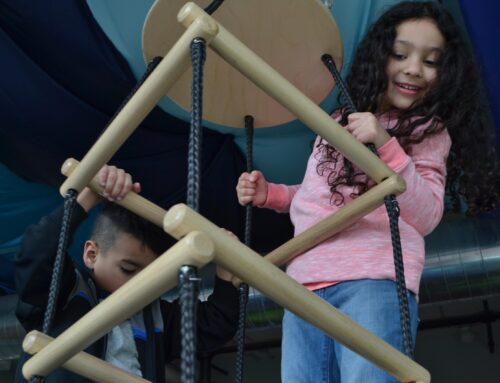With spring rising from the cold, there comes a feeling of rebirth and readiness for something new. Our little blue birds are shaking away the cold by raising their arms high into the air and moving their bodies into new shapes and poses through yoga. This blog talks about the benefits of yoga for children and gives ideas to help your family try it out at home. Yoga has a rich spiritual history seeking to connect the mind and the body. These poses — originating in India — are utilized to help people strengthen and stretch their bodies, as well as focus their attention and quiet their minds.
Yoga has become popular with adults and children alike. Kids with different abilities are no different. Studies show that yoga is a great tool to improve motor coordination, self-regulation, imitation skills, and self-awareness. These are all necessary skills to help kids participate on the playground and with peers. [Please see a few research articles below if you are interested.]
Yoga does not have to be something just practiced at school. It is a great opportunity for you and your child to grow your bodies and minds, as well as your relationship. Taking a few minutes out of the day to do one pose together, or to practice breathing techniques, is a great way to support your child and your health. Here are some suggestions and resources to help your family grow into the practice of yoga.

- Start small. All kids and adults have a variety of skills and interests. Acknowledge that it may take time to learn poses and that everyone has different interests that support their learning. A first step could be looking at/reading a kid’s yoga book, taking big breaths, watching a yoga video, or having your kids just see you in a pose. If you are unsure, look online, ask a yoga instructor, or ask your occupational or physical therapist where you should start with your child.
- Resources. There are so many kid-friendly apps, books, videos, and blogs. Feel free to check them all out. Here are a few that I’ve used. Figure out what interests your child the most and what fits best for your lifestyle. There are a ton of resources online.
Books – Good Morning Yoga: A Pose-by-Pose Wake Up Story by Mariam Gates, You are a Lion by Taeeun Yoo
Apps – Super Stretch Yoga (free)
Videos – Cosmic Kids Yoga (YouTube channel with engaging and fun stories, including frozen, dinosaurs, and mermaids around yoga; some of the poses may be better suited for older kids) - Slow and Steady. If you get to the point of assuming positions: Great! See how long you both can hold them. Wait to add in more poses until your child really has it, then add new poses in slowly.
- Celebrate. Once you get that pose or even attempt a new pose: celebrate. Take the time to celebrate you and your child’s body and mind power. Take a picture of your pose. Smile. Play a favorite song. Offer big hugs. Tickles. Say “Wow your body makes all kinds of cool shapes” or “I love the way you did that pose.” Do something that your child finds fun to celebrate your child’s achievement; not only to help their yoga and coordination, but also their mind and self-esteem.
Have fun growing together this spring and reach out to your team for more activities to help your children grow!
Research Resources
Radhakrishna, S., Nagarathna, R., & Nagendra, H. R. (2010). Integrated approach to yoga therapy and autism spectrum disorders. Journal of Ayurveda and integrative medicine, 1(2), 120-4.
Koenig KP, Buckley-Reen A, Garg S. Efficacy of the Get Ready to Learn yoga program among children with autism spectrum disorders: A pretest-posttest control group design. Am J Occup Ther. 2012;66:538–46.
Galantino ML, Galbavy R, Quinn L. Therapeutic effects of yoga for children: a systematic review of the literature. Pediatric Physcal Therapy. 2008;20(1):66-80,

Blue Bird Day fosters socialization, sensory regulation, and pre-academic learning in children ages 2-7 years in therapeutic rotations that simulate preschool and kindergarten settings. Our compassionate therapists practice a relationship-based and family-centered approach, provide parent training, and collaborate on goals and individualized intensive treatment plans for your child.
We believe in a collaborative and multi-disciplinary team approach to therapy. A team of occupational therapists, speech-language pathologists, dietitians, developmental therapists, behavioral therapists, physical therapists, and therapeutic assistants are created for each child to ensure child and family are fully supported and the best possible results are achieved.
Options for individualized, group and virtual therapy sessions are available as well.
Want to learn more or you have a specific question? Feel free to connect with us here!



